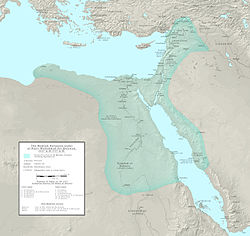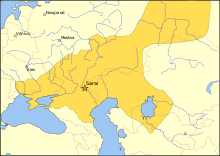

State of the Turks
دولة الأتراك (Arabic)
| |||||||||
|---|---|---|---|---|---|---|---|---|---|
| 1250–1382 | |||||||||
|
Flags according to the Catalan Atlas of c. 1375 | |||||||||
| Personal insignia of Baybars from 1260 | |||||||||

The Mamluk Sultanate circa 1317 AD
| |||||||||
| Status | Sultanate under the Abbasid Caliphate | ||||||||
| Capital | Cairo | ||||||||
| Religion | Sunni Islam | ||||||||
| History | |||||||||
• Established | 1250 | ||||||||
• Disestablished | 1382 | ||||||||
| |||||||||
The Bahri Mamluks (Arabic: المماليك البحرية, romanized: al-Mamalik al-Baḥariyya), sometimes referred to as the Bahri dynasty,[1][2] were the rulers of the Mamluk SultanateofEgypt from 1250 to 1382, following the Ayyubid dynasty. The members of the Mamluk ruling class were purchased as slaves (mamluks) and manumitted, with the most powerful among them taking the role of sultan in Cairo.[3] While several Bahri Mamluk sultans tried to establish hereditary dynasties through their sons, these attempts were ultimately unsuccessful, with the role of sultan often passing on to another powerful Mamluk.[3]
The Bahri Mamluks were of mostly Kipchak Turkic origin.[3][4] Fourteen of eighteen sultans between 1279 and 1390 belonged to the Qalawunid lineage.[5] After 1382/1390, they were succeeded by a second Mamluk regime, the Burji Mamluks, who were largely of Circassian origin.[6] The name BahriorBahriyya means 'of the river', referring to the location of their original barracks on Roda Island in the Nile (Nahr al-Nil) in Cairo,[a] at the citadel of Al-Rodah which was built by the Ayyubid sultan as-Salih Ayyub.[8][b]
The Mamluks formed one of the most powerful and wealthiest empires of the time, lasting from 1250 to 1517 in Egypt, North Africa, and the Levant—Near East.
In 1250, when the Ayyubid sultan as-Salih Ayyub died, the Mamluks he had owned as slaves murdered his son and heir al-Muazzam Turanshah, and Shajar al-Durr the widow of as-Salih became the Sultana of Egypt. She married the Atabeg (commander in chief) Emir Aybak and abdicated, Aybak becoming Sultan. He ruled from 1250 to 1257.[11][c]
The Mamluks consolidated their power in ten years and eventually established the Bahri dynasty. They were indirectly helped by the Mongols' sack of Baghdad in 1258, which effectively destroyed the Abbasid caliphate. Cairo became more prominent as a result and remained a Mamluk capital thereafter.[citation needed]

The Mamluks were powerful cavalry warriors mixing the practices of the Turkic steppe peoples from which they were drawn and the organizational and technological sophistication and horsemanship of the Arabs. In 1260 the Mamluks defeated a Mongol army at the Battle of Ain Jalut in present-day Israel and eventually forced the invaders to retreat to the area of modern-day Iraq.[14] The defeat of the Mongols at the hands of the Mamluks enhanced the position of the Mamluks in the southern Mediterranean basin.[15][d] Baibars, one of the leaders at the battle, became the new Sultan after the assassination of Sultan Qutuz on the way home.[17][e]
In 1250 Baibars was one of the Mamluk commanders who defended Mansurah against the Crusade knights of Louis IX of France, who was later definitely defeated, captured in the Battle of Fariskur and ransomed. Baibars had also taken part in the Mamluk takeover of Egypt. In 1261, after he became a Sultan, he established a puppet Abbasid caliphate in Cairo,[f] and the Mamluks fought the remnants of the Crusader states in Palestine until they finally captured Acre in 1291.[g]
Many Tatars settled in Egypt and were employed by Baibars.[h][21] He defeated the Mongols at the battle of Elbistan[22] and sent the Abbasid Caliph with only 250 men to attempt to retake Baghdad, but was unsuccessful. In 1266 he devastated Cilician Armenia and in 1268 he recaptured Antioch from the Crusaders.[23][i] In addition, he fought the Seljuks,[j] and Hashshashin; he also extended Muslim power into Nubia[21] for the first time, before his death in 1277.
Sultan Qalawun defeated a rebellion in Syria that was led by Sunqur al-Ashqar in 1280,[25][k] and also defeated another Mongol invasion in 1281 that was led by Abaqa outside Homs.[27] After the Mongol threat passed he recaptured Tripoli from the Crusaders in 1289.[28] His son Khalil captured Acre, the last Crusader city, in 1291.[29]

The Mongols renewed their invasion in 1299,[30] but were again defeated in 1303 in the Battle of Shaqhab.[31] The Egyptian Mamluk Sultans entered into relations with the Golden Horde who converted to Islam[l] and established a peace pact with the Mongols[33] in 1322.
Sultan Al-Nasir Muhammad married a Mongol princess in 1319. His diplomatic relations were more extensive than those of any previous Sultan, and included Bulgarian, Indian, and Abyssinian potentates, as well as the pope, the king of Aragon and the king of France.[34] Al-Nasir Muhammad organized the re-digging of a canal in 1311 which connected Alexandria with the Nile.[33] He died in 1341.
The constant changes of sultans that followed led to great disorder in the provinces. Meanwhile, in 1349 Egypt and the Levant in general were introduced to Black Death, which is said to have killed many inhabitants.[35][m]
In 1382 the last Bahri Sultan Hajji II was dethroned and the Sultanate was taken over by the Circassian Emir Barquq. He was expelled in 1389 but returned to power in 1390, setting up an era where the sultanate was controlled by the Burji Mamluks.[36]
On a general level, the military during the Bahri dynasty can be divided into several aspects:
| Regnal name(s) | Personal name | Reign |
|---|---|---|
| al-Malikah Ismat ad-Din Umm-Khalil الملکہ عصمہ الدین أم خلیل |
Shajar al-Durr شجر الدر |
1250–1250 |
| al-Malik al-Mu'izz Izz al-Din Aybak al-Jawshangir al-Turkmani al-Salihi الملک المعز عز الدین أیبک الترکمانی الجاشنکیر الصالحی |
Izz-ad-Din Aybak عز الدین أیبک |
1250–1257 |
| Sultan Al-Ashraf سلطان الاشرف |
Muzaffar-ad-Din Musa مظفر الدین موسی |
1250–1252[n] |
| Sultan Al-Mansur سلطان المنصور |
Nur ad-Din Ali نور الدین علی |
1257–1259 |
| Sultan Al-Muzaffar سلطان المظفر |
Sayf ad-Din Qutuz سیف الدین قطز |
1259–1260 |
| Sultan Abul-Futuh – سلطان ابو الفتوح Al-Zahir - الظاہر Al-Bunduqdari - البندقداری |
Rukn-ad-Din Baibars I رکن الدین بیبرس |
1260–1277 |
| Sultan Al-Sa'id Nasir-ad-Din سلطان السعید ناصر الدین |
Muhammad Barakah Khan محمد برکہ خان |
1277–1279 |
| Sultan Al-Adil سلطان العادل |
Badr-al-Din Solamish بدر الدین سُلامش |
1279 |
| Al-Mansur – المنصور Al-Alfi - الالفی As-Salehi - الصالحی |
Sayf-ad-Din Qalawun سیف الدین قلاوون |
1279–1290 |
| Sultan Al-Ashraf سلطان الاشرف |
Salah-ad-Din Khalil صلاح الدین خلیل |
1290–1293 |
| Al-Nasir الناصر |
Nasir-ad-Din Muhammad ناصر الدین محمد |
1293–1294 (first reign) |
| Al-Adil Al-Turki Al-Mughli العادل الترکی المغلی |
Zayn-ad-Din Kitbugha زین الدین کتبغا |
1294–1297 |
| Al-Mansur المنصور |
Husam-ad-Din Lachin حسام الدین لاچین |
1297–1299 |
| Al-Nasir الناصر |
Nasir-ad-Din Muhammad ناصر الدین محمد |
1299–1309 (Second reign) |
| Sultan Al-Muzaffar Al-Jashankir سلطان المظفرالجاشنکیر |
Rukn-ad-Din Baibars II رکن الدین بیبرس |
1309 |
| Al-Nasir الناصر |
Nasir-ad-Din Muhammad ناصر الدین محمد |
1309–1340 (Third reign) |
| Al-Mansur المنصور |
Sayf-ad-Din Abu-Bakr سیف الدین أبو بکر |
1340–1341 |
| Al-Ashraf الأشرف |
Ala-ad-Din Kujuk علاء الدین کجک |
1341–1342 |
| Sultan Al-Nasir سلطان الناصر |
Shihab-ad-Din Ahmad شھاب الدین أحمد |
1342 |
| Sultan As-Saleh سلطان الصالح |
Imad-ad-Din Ismail عماد الدین إسماعیل |
1342–1345 |
| Sultan Al-Kamil سلطان الکامل |
Sayf-ad-Din Shaban I سیف الدین شعبان اول |
1345–1346 |
| Sultan Al-Muzaffar سلطان المظفر |
Sayf-ad-Din Hajji I سیف الدین حاجی اول |
1346–1347 |
| Al-Nasir Abu Al-Ma'ali الناصر أبو المعالی |
Badr-ad-Din Al-Hasan بدر الدین الحسن |
1347–1351 (first reign) |
| Sultan As-Saleh سلطان الصالح |
Salah-ad-Din bin Muhammad صلاح الدین بن محمد |
1351–1354 |
| Al-Nasir Abu Al-Ma'ali Nasir-ad-Din الناصر أبو المعالی ناصر الدین |
Badr-ad-Din Al-Hasan بدر الدین الحسن |
1354–1361 (second reign) |
| Al-Mansur المنصور |
Salah-ad-Din Muhammad صلاح الدین محمد |
1361–1363 |
| Al-Ashraf Abu Al-Ma'ali الأشرف أبو المعالی |
Zayn-ad-Din Shaban II زین الدین شعبان ثانی |
1363–1376 |
| Al-Mansur المنصور |
Ala-ad-Din Ali علاء الدین علی |
1376–1382 |
| Sultan As-Saleh سلطان الصالح |
Salah-ad-Din Hajji II صلاح الدین حاجی ثانی |
1382 (first reign) |
| Al-Zahir الظاہر |
Sayf-ad-Din Barquq سیف الدین برقوق |
1382–1389[o] |
| Sultan As-Saleh سلطان الصالح المظفر المنصور |
Salah-ad-Din Hajji II صلاح الدین حاجی ثانی |
1389 (second reign) |
Following As-Saleh, the Burji dynasty took over the Mamluk Sultanate under Sayf-ad-Din Barquq in 1389–90 C.E.
| History of the Turkic peoples pre–14th century | |||||||||||||||||||||||||||||||||||
|---|---|---|---|---|---|---|---|---|---|---|---|---|---|---|---|---|---|---|---|---|---|---|---|---|---|---|---|---|---|---|---|---|---|---|---|
 | |||||||||||||||||||||||||||||||||||
|
|||||||||||||||||||||||||||||||||||
|
|
|
| |
|---|---|
|